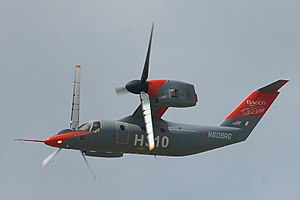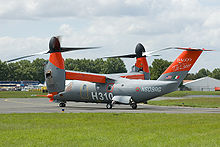AgustaWestland AW609
| AW609 | |
|---|---|
 Bell-Agusta BA609 (2007) |
|
| Type: | Tilt rotor aircraft |
| Design country: | |
| Manufacturer: | |
| First flight: |
March 7, 2003 |
| Commissioning: |
Still in flight testing |
| Production time: |
Certification and series production planned for 2018 |
| Number of pieces: |
4 prototypes, (as of February 2017) |
The AgustaWestland AW609 , formerly Bell / Agusta BA609 , is a vertical take-off tilt rotor - convertible aircraft similar to the Bell Boeing V-22 . Since 2011 the project has been operated by AgustaWestland . Since April 28, 2016, the developer of the Finmeccanica project has been operating under the name Leonardo-Finmeccanica-Società per azioni , and from January 1, 2017 the company name will be abbreviated as Leonardo SpA
history
At the end of 1996, Bell-Boeing presented the concept of a civil tilt-rotor aircraft D-600 ; the first flight as BB609 was supposed to take place in 1999 and the delivery from 2001. In September 1998 Bell and Agusta announced that they would continue the project under the name BA609 and showed a first prototype at exhibitions.
Two V-22 Osprey accidents in April and December 2000 with 23 deaths delayed closely related projects, as did financial cuts. The first ground tests of the BA609 finally began on December 6, 2002. The maiden flight took place on March 7, 2003 in Arlington ( Texas / USA ) by the pilots Roy Hopkins and Dwayne Williams. The aircraft is designed for one to two crew members and up to nine passengers.
Due to problems in the development of the V-22 Osprey , this project was delayed again and again, as it is technically closely related to the Osprey used by the military . For example, the signals for flight control are transmitted without mechanical parts . In 2014, successful autorotation tests took place in Texas under the supervision of the Federal Aviation Administration .
Traffic approval by the European Aviation Safety Agency (EASA) and the US FAA was planned for 2017. After the accident in October 2015 (see incidents ), it was delayed from May 2018 until at least the end of 2019.
Tests on the 1st prototype (A / C1) were resumed on April 15, 2016. On May 4, 2016, the first ground run with the 3rd prototype (A / C3) took place in Cascina Costa (Italy). In May 2016, the 4th prototype (A / C4) was in the construction phase in Philadelphia, PA (USA).
In February 2018, Leonardo announced that the US helicopter company ERA Group had ordered two aircraft for 2020.
The fourth prototype with the registration number N609PH first flew on December 23, 2019 in Philadelphia in the US state of Philadelphia. The aircraft is the first example of the type that corresponds to the series standard and is to be approved in the new category "Powered Lift" of the US aviation authority FAA.
Flight performance in comparison
The special thing about the AW609 is that it can take off and land vertically like a helicopter, but it also reaches a high airspeed. This is made possible by two large engines and the design with tilt rotors. Compared to a conventional helicopter such as the HAL Dhruv , which can carry up to twelve passengers with a payload of 2500 kg, the AW609 has about twice the engine power and twice the curb weight. But it is more than twice as fast and can fly almost four times as far.
Incidents
On October 30, 2015, the second prototype with the aircraft registration number N609AG crashed near Santhià in north-western Italy during a test flight. Both pilots were killed. The plane broke in midair about 27 minutes after takeoff while the pilots were diving at high speed - 293 knots (542 km / h). On the unfortunate flight, modifications to the stern and the flight mechanical control rules were tested for the first time. According to the investigating authorities, these caused a tumbling oscillation during the dive , i.e. H. to an alternating swing around the longitudinal and vertical axis , which ultimately led to the prototype breaking apart. In June 2016 it was announced that based on the findings, the manufacturer would have to check its computer models to calculate flight behavior beforehand and to revise the flight control systems. The flight tests were resumed in August 2016.
Technical specifications
| Parameter | Data |
|---|---|
| crew | 1-2 |
| Passengers | 6-9 |
| length | 14.10 m (given by AgustaWestland) |
| height | 4.5 m / 5.1 m (given by AgustaWestland) |
| Wingspan | 11.7 m |
| Rotor diameter | 7.93 m |
| Overall width | 18.29 m (main rotors running) |
| Empty weight | 4765 kg |
| payload | 2500 kg |
| total weight | 7260 kg (max.) |
| Takeoff weight | 7631 kg (max.) |
| Engines | Pratt & Whitney PT6C-67A |
| Starting power | 2 × 1447 kW |
| Continuous output | 2 × 1249 kW |
| Cruising speed | 510 km / h (max.) |
| Hovering flight without ground effect | 1501 m (max.) |
| Altitude | 7625 m (max.) |
| Range | 1296 km (max., Standard tanks ) (information from AgustaWestland) 1390 km (max., With additional tank, without reserve) |
| price | about $ 10 million |
| operating cost | about $ 875 an hour |
See also
Web links
- AW609 TiltRotor. In: Products & Services - Helicopters. Leonardo-Finmeccanica, 2016, accessed on February 21, 2017 .
- BA609 page at Aerospace Technology (English)
- Private aircraft website bredow-web.de via the BA609
Individual evidence
- ↑ Paris Air Show: AgustaWestland takes over BA609 tipping rotor program Flugrevue.de, accessed on June 25, 2011.
- ↑ http://www.leonardocompany.com/en/-/statuto-sociale-articles-association LEONARDO: FILING OF ARTICLES OF ASSOCIATION, January 10, 2017.
- ^ Ramon Lopez: Bell-Boeing agrees civil tilt-rotor. In: Headlines. Flight International , October 30, 1996, p. 4 , accessed June 2, 2015 .
- ^ Bell Boeing takes the wraps off the BB609 civil tilt-rotor. In: NBAA Show Report. Flight International, November 27, 1996, p. 10 , accessed June 2, 2015 .
- ^ Agusta and Bell team on new programs. In: Farnborough '98 Report . Flight International, September 16, 1998, p. 12 , accessed June 2, 2015 .
- ^ Paul Lewis: Bell admits future of BA609 is tied to troubled V-22 Osprey. In: Business & General Aviation. Flight International, March 26, 2002, p. 30 , accessed on June 3, 2015 (English): "Development of civil tiltrotor slows as maker confirms link with grounded military V-22"
- ↑ Cash shortage delays BA609 work. In: Business & General Aviation. Flight International, March 19, 2002, p. 6 , accessed on June 3, 2015 (English): "The partners had hoped to get the first test tiltrotor airborne by June [2002], but this is looking increasingly unlikely."
- ↑ AW609 tiltRotor aircraft completes autorotation trials gizmag.com, accessed April 29, 2014
- ↑ http://www.leonardocompany.com/en/-/aw609-ground-run AW609 TiltRotor: Third Prototype Closer to Maiden Flight Following Ground Run. Leonardo, May 4, 2016, accessed July 1, 2016
- ^ Era Group to mark entry of AW609 tiltrotor into the US commercial market. In: Press Releases and News. Leonardo SpA, February 27, 2018, accessed on February 28, 2018 (English): "Under the agreement, Era will take delivery of two AW609s plus training package in 2020."
- ↑ Volker K. Thomalla : Leonardo's tiltrotor AW609 number 4 flies. Aerobuzz.de, December 27, 2019, accessed December 28, 2019 .
- ↑ FlightGlobal: AW609 crash kills two pilots in northern Italy. Retrieved October 30, 2015 .
- ↑ Flugrevue: AW609 crashes in Italy. Retrieved October 30, 2015 .
- ↑ Vertical Mag: AgustaWestland: AW609 was performing high-speed tests on the day of crash. Retrieved June 26, 2016 .
- ↑ FlightGlobal: AW609 control laws initiated 'Dutch roll': investigators. Retrieved June 26, 2016 .
- ↑ BA609 TiltRotor. (PDF) Bell / Agusta Aerospace Company, 2004, archived from the original on January 4, 2006 ; accessed on December 20, 2017 .
- ↑ a b c AgustaWestland: AW609


